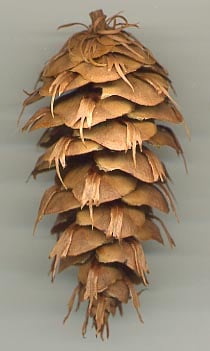Difference between revisions of "Gymnosperm" - New World Encyclopedia
Rick Swarts (talk | contribs) (Added article and credit tags) |
|||
| Line 1: | Line 1: | ||
| + | {{Contracted}} | ||
[[Image:Pseudotsuga menziesii cone.jpg|right|thumb|[[Coast Douglas-fir]] cone]] | [[Image:Pseudotsuga menziesii cone.jpg|right|thumb|[[Coast Douglas-fir]] cone]] | ||
Revision as of 22:30, 10 May 2006
Gymnosperms (Gymnospermae) is a name for a group of seed-bearing (and thus vascular) plants. The term gymnosperm comes from the Greek word gumnospermos, literally meaning "naked seed": this is because the seeds of these plants are not formed in an ovule that is enclosed (and developing into a fruit, in the angiosperms), but naked on the scales of a cone or cone-like structure.
The production of seeds distinguishes the gymnosperms (along with the angiosperms) from other members of the vascular plants. Thus together they are called seed plants (Spermatophyta).
Gymnosperms are heterosporous, producing microspores that develop into pollen grains and megaspores that are retained in an ovule. After fertilization (joining of the micro- and megaspore), the resulting embryo, along with other cells comprising the ovule, develops into a seed. The seed is a sporophyte resting stage.
In early classification schemes, the gymnosperms (Gymnospermae) "naked seed" plants were regarded as a "natural" group. However, fossil finds suggest that the angiosperms evolved from a gymnosperm ancestor, which would make the gymnosperms a paraphyletic group if all extinct taxa are included. Modern cladistics only accepts taxa that are monophyletic, traceable to a common ancestor and inclusive of all descendants of that common ancestor. So, while the term gymnosperm is still widely used for non-angiosperm seed-bearing plants, the plant species once treated as gymnosperms are usually distributed among four groups, which can be given equal rank as divisions within the Kingdom Plantae. These groups are:
- Division Pinophyta – Conifers
- Division Ginkgophyta – Ginkgo
- Division Cycadophyta – Cycads
- Division Gnetophyta – Gnetum, Ephedra, Welwitschia
With regard to extant gymnosperms, molecular phylogenies of living taxa have conflicted with morphological datasets with regard to whether they comprise a monophyletic or paraphyletic group with respect to angiosperms. At issue is whether the Gnetophyta are the sister taxon to angiosperms, or whether they are sister to, or nested within, other extant gymnosperms.
ReferencesISBN links support NWE through referral fees
- Bowe, L. Michelle, Gwénaële Coat, and Claude W. dePamphilis. 2000. Phylogeny of seed plants based on all three genomic compartments: Extant gymnosperms are monophyletic and Gnetales' closest relatives are conifers. Proceedings of the National Academy of Sciences 97: 4092-4097 (abstract).
- Soltis, Douglas E., Pamela S. Soltis and Michael J. Zanis. 2002. Phylogeny of seed plants based on evidence from eight genes. American Journal of Botany 89: 1670-1681 (abstract).
- Chaw, Shu-Miaw, Christopher L. Parkinson, Yuchang Cheng, Thomas M. Vincent, and Jeffrey D. Palmer. 2000. Seed plant phylogeny inferred from all three plant genomes: Monophyly of extant gymnosperms and origin of Gnetales from conifers. Proceedings of the National Academy of Sciences 97: 4086-4091 (abstract).
External links
Credits
New World Encyclopedia writers and editors rewrote and completed the Wikipedia article in accordance with New World Encyclopedia standards. This article abides by terms of the Creative Commons CC-by-sa 3.0 License (CC-by-sa), which may be used and disseminated with proper attribution. Credit is due under the terms of this license that can reference both the New World Encyclopedia contributors and the selfless volunteer contributors of the Wikimedia Foundation. To cite this article click here for a list of acceptable citing formats.The history of earlier contributions by wikipedians is accessible to researchers here:
The history of this article since it was imported to New World Encyclopedia:
Note: Some restrictions may apply to use of individual images which are separately licensed.
